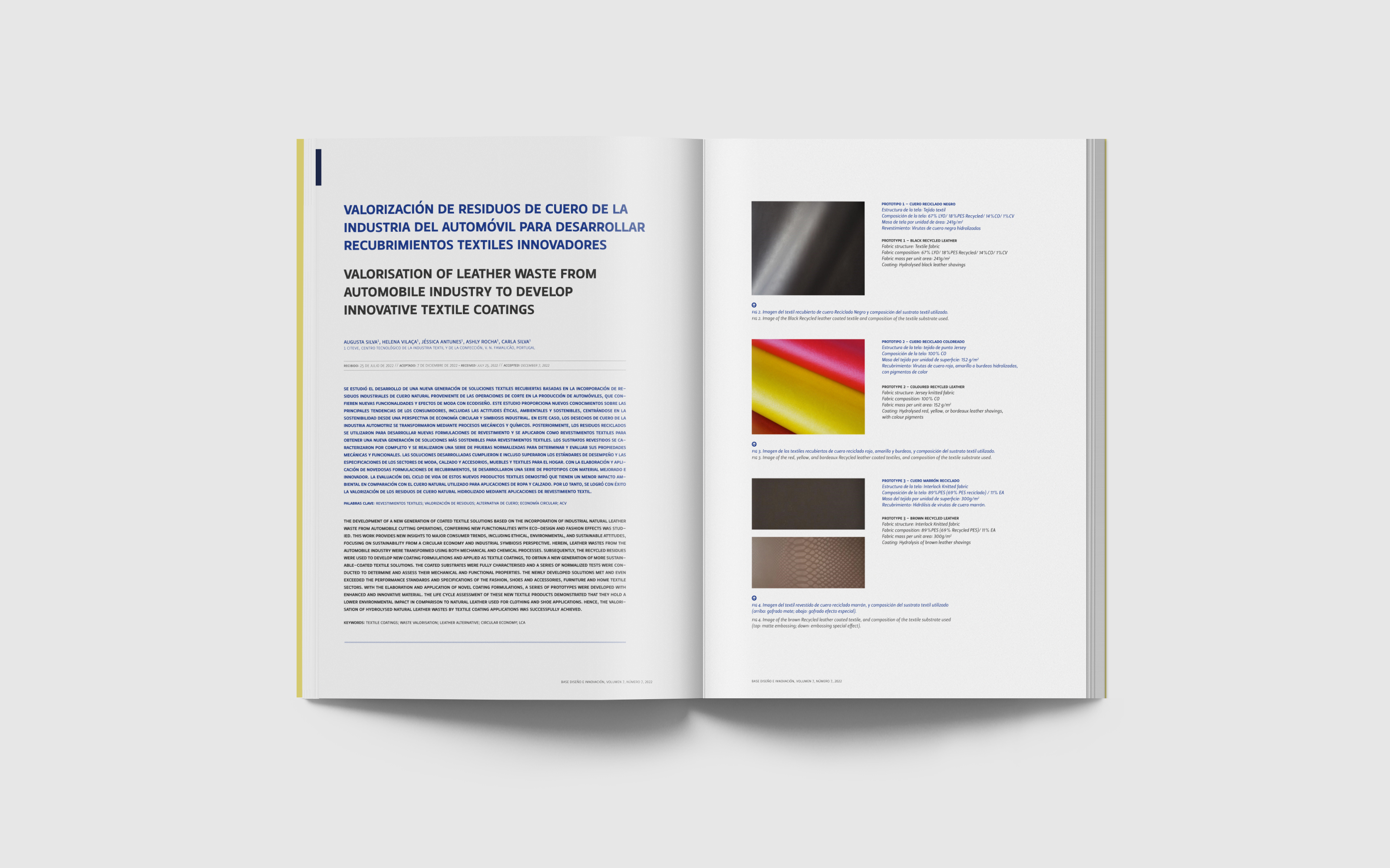Valorisation of leather waste from automobile industry to develop innovative textile coatings
Main Article Content
Abstract
The development of a new generation of coated textile solutions based on the incorporation of industrial natural leather waste from automobile cutting operations, conferring new functionalities with eco-design and fashion effects was studied. This work provides new insights to major consumer trends, including ethical, environmental, and sustainable attitudes, focusing on sustainability from a circular economy and industrial symbiosis perspective. Herein, leather wastes from the automobile industry were transformed using both mechanical and chemical processes. Subsequently, the recycled residues were used to develop new coating formulations and applied as textile coatings, to obtain a new generation of more sustainable-coated textile solutions. The coated substrates were fully characterised and a series of normalized tests were conducted to determine and assess their mechanical and functional properties. The newly developed solutions met and even exceeded the performance standards and specifications of the fashion, shoes and accessories, furniture and home textile sectors. With the elaboration and application of novel coating formulations, a series of prototypes were developed with enhanced and innovative material. The Life Cycle Assessment of these new textile products demonstrated that they hold a lower environmental impact in comparison to natural leather used for clothing and shoe applications. Hence, the valorisation of hydrolysed natural leather wastes by textile coating applications was successfully achieved.
Article Details
References
Chojnacka, K., Skrzypczak, D., Mikula, K., Witek-Krowiak, A., Izydorczyk, G., Kuligowski, K., ... & Ku?a?y?ski, M. (2021). Progress in sustainable technologies of leather wastes valorization as solutions for the circular economy. Journal of Cleaner Production, 313, 127902. https://doi.org/10.1016/j.jclepro.2021.127902
Ebabu, W., Israil Hossain, M., El-Naggar, M. E., Kechi, A., Hailemariam, S. S., & Ahmed, F. E. (2022). Exploration of Functional Polymers for Cleaner Leather Industry. Journal of Inorganic and Organometallic Polymers and Materials, 32, 1-14. https://doi.org/10.1007/s10904-021-02129-4
EcoDomo - Sustainable Leathers and Fabrication. (n.d.). Retrieved from Ecodomo: https://www.ecodomo.com/
Fabric Suplly Incorporated (n.d.). https://www.fabricsupply.com/products/embrace-recycled-leather/
Favini (2017). Remake. The up-cycled paper from leather residues. https://www.favini.com/gs/en/fine-papers/remake/features-applications/
Ferreira, M. J. (2012). Contribuições para a Gestão de Resíduos de Couro Curtido com Crómio da Indústria do Calçado. Retrieved from www.ctcp.pt
Gelatex. (n.d.). https://www.gelatex.com/
Körlü, A. (Ed.). (2020). Waste in Textile and Leather Sectors. IntechOpen. https://doi.org/10.5772/intechopen.90014
?awi?ska, K. (2021). Production of Agglomerates, Composite Materials, and Seed Coatings from Tannery Waste as New Methods for Its Management. Materials, 14(21), 6695. https://doi.org/10.3390/ma14216695
Li, Y., Guo, R., Lu, W. et al. (2019) Research progress on resource utilization of leather solid waste. Journal of Leather Science and Engineering 1(6). 1-17. https://doi.org/10.1186/s42825-019-0008-6
Moreira, S. C. P. A. (2008). Estudo da obtenção de Gelatina a partir de Raspa Wet-Blue da Indústria de Curtumes [Doctoral dissertation] Instituto Politecnico do Porto]. Repositório P.Porto https://recipp.ipp.pt/bitstream/10400.22/2405/1/DM_SilvanaMoreira_2008_MEQ.pdf
Pyle, C. (2012). What is Recycled Leather? Natural Upholstery Consultation. https://naturalupholstery.com/2012/09/what-is-recycled-leather/
Recyc Leather (n.d.). http://www.recycleather.com/
Santos, M. A. (2015). Patent No. BR 10 2013 028947 7 A2.
Usenbekov J., Seitov B.K., Nurbay S.K., Abenova I.R. (2020). Recycling of leather and shoe waste. The Journal of Almaty Technological University, 2020(3), 48-52. https://doi.org/10.48184/2304-568X-2020-3-48-52


